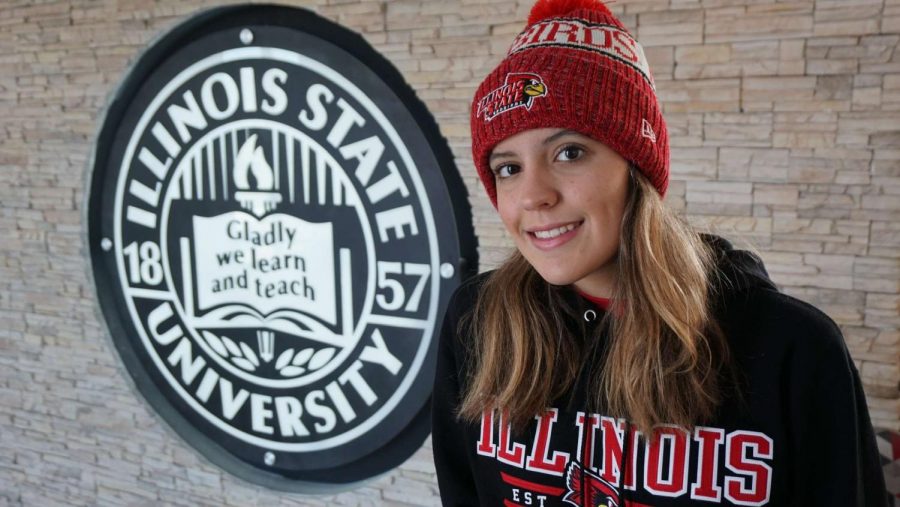Glaspie’s commitment to ISU, D1 athletics
Milford Senior Ella Glaspie verbally committed to swim and attend Illinois State University in November of 2019 and plans to pursue majors in Advanced Marketing Analytics and Psychology (Photo courtesy of Matt Glaspie).
May 25, 2021
Like many competitive athletes, Senior Ella Glaspie has always wanted to compete in college. “It is something that I’ve always dreamed of doing, and my entire high school career was based on training to become a collegiate athlete,” she stated.
For some, this dream becomes a reality, but for many others, it becomes a faded memory; Glaspie is one of few who will continue her athletic career as a Division-I athlete.
Years of hard work in and out of the pool, coupled with immense sacrifice and years of preparation, led Glaspie to commit as a swimmer at Illinois State University: “Overall, I looked at nearly 30 different schools across the country, so I could fully understand what I wanted from both the college itself and the swim programs,” Glaspie explained. “I settled on ISU because I loved the campus, the team, the coach, it had the major I was interested in pursuing and the proximity to home. When choosing a school, you have to go with your gut instinct–wherever you feel the most at home is where you belong.”
Glaspie will begin her collegiate swimming career this fall while pursuing degrees in Advanced Marketing Analytics and Psychology and will be in her school’s honors college.
Ella’s love of the sport started when she was very young. “Growing up as a year-round club swimmer, she observed many college signing days with older teammates and dreamed one day her turn would come,” said Glaspie’s mother, Ann Marie Hribar. “Ella knew she had the potential to compete at this level based on her age group performance, but getting there requires lots of hard work, discipline, and dedication. My role is really to support Ella on her journey–celebrating the highs, but also helping her maneuver through the lows.”
Athletes must be fully immersed in their sport and show passion each day to continue achieving their goals. For those willing to put forth the effort, it can be an extremely rewarding experience and bring numerous opportunities otherwise unattainable, and with the support of peers hoping to do the same: “I’m a big believer that competing any sport in college at any level gives you an immediate support group to grow,” ISU Coach Caitlyn Hamilton shared. “You’ll be challenged, but you’ll also have twenty-plus people as your cheerleaders to celebrate your successes with. There’s really nothing like it.”
To lead this type of lifestyle, the athlete must be firmly devoted to his/her sport and taking care of all aspects of him/herself beyond training. “Leading up to my commitment, my life was filled with four-hour-long practices each day and meets nearly every weekend. The intensity of my schedule did take a toll on my mental health—I was extremely exhausted all the time, and it was oftentimes hard to manage my vigorous classes and practices,” Glaspie said. “Despite the brutality of this time period, I am 100% glad I stuck with it, because I could not imagine my future without swimming.”
One of the first major steps for prospective college athletes is enrollment with the NCAA Eligibility Center; after that, students must complete student-athlete profiles on recruitment websites and reach out to coaches through email and video calls before traveling for campus visits, both official and unofficial.
The school that a student chooses to attend should be a positive fit in all sectors of student life, not just athletics. “We whittled down the list to approximately 50 colleges, including both safety and stretch schools,” Hribar explained. “Then, the ‘self-marketing’ begins…the list of schools was continually refined by the level of interest from both the coaches as well as Ella until there was one clear choice. As a mom, it is very reassuring to know Ella will have a built-in community right from the start–Ella found a ‘home’ at ISU.”
The community that Hribar describes is one of the many stand-out factors that reinforced Glaspie’s choice to pursue her next four years at ISU: “Doing a sport for so long can be mentally draining and I just want to remember why I love the sport I do,” she stated. “Swimming itself is obviously very important to me; however, the relationships involved with the sport make it so much better.”
On the recruiter’s end, similar ‘boxes’ must be checked in order to ensure that prospective athletes will be a positive asset to the school and its programs. “As I recruit, I’m trying to find the best fit and total package to add to the team–someone who is driven, passionate, bright, and has big goals,” Hamilton said. “Ella checked off all of those for us.”
Despite the rollercoaster of the college recruitment process, Glaspie encourages those who are truly dedicated to their sport long-term to research their options for future involvement. A sport can offer so much more than just the experiences practicing on the field, court, or in the pool, and the unique opportunities that come from the relationships, travel, and training can teach endless lessons that are applicable for years to come.
Regardless, it is a rigorous path to take, and it isn’t for everyone. Glaspie advises others in her position to consider all possibilities and make the best decision for themselves as individuals. “Remember what your goal is. Even if other people choose to slack off or pester you about ‘trying too hard,’ you need to understand that what you want is so much bigger than just that,” Glaspie said. “Although this can be difficult, in the long run, you will fully understand why you trained so hard.”
